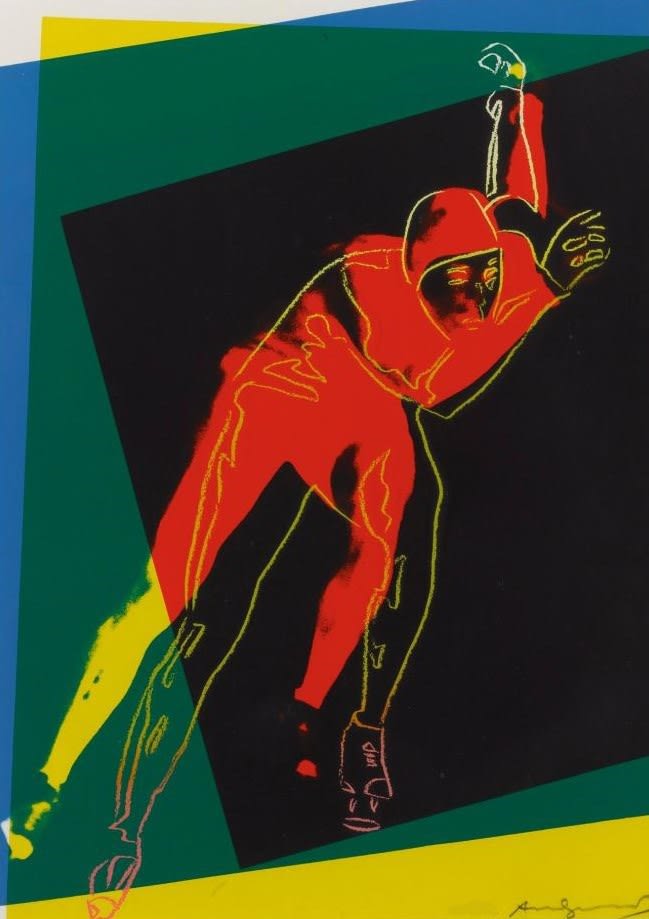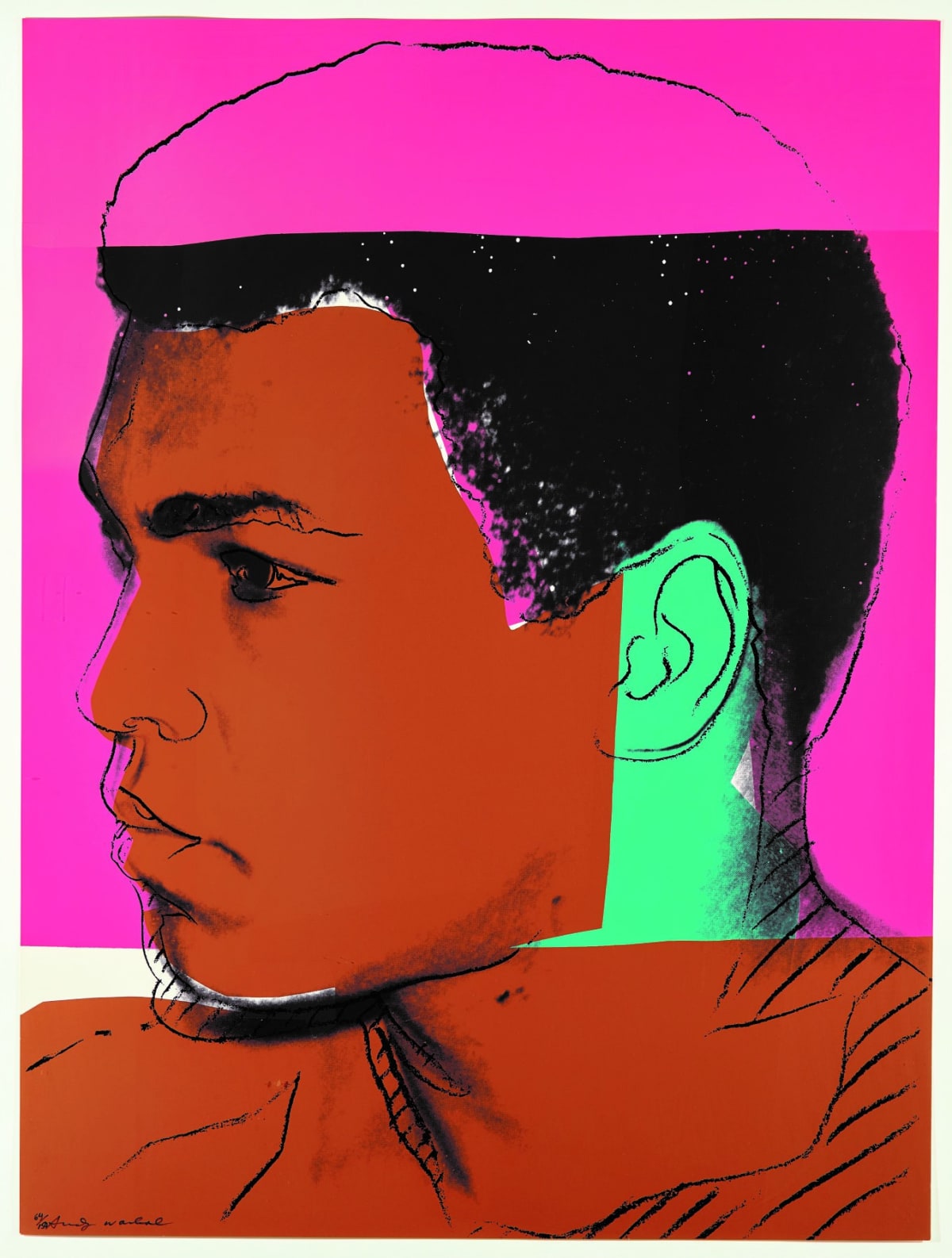
Warhol’s most immediate exploration of sport and its stars can be found in his 1977 series “The Athletes” which consists of ten portraits of renowned athletes. Commissioned by friend and collector Richard Weisman, the series features iconic athletes, including Muhammad Ali, O.J. Simpson, Dorothy Hamill, Kareem Abdul-Jabbar, Chris Evert, Jack Nicklaus, Willie Shoemaker, Rod Gilbert, Tom Seaver, and Pelé.These portraits show a departure from Warhol's subjects of high society, demonstrating a period when sports stars were becoming celebrities in their own right.
Weisman proposed the idea of creating portraits of sports figures to Warhol, despite the artist's limited knowledge of sports. Weisman personally selected the athletes for the series.
In his print production, Warhol also examined the world of sports stars and iconography. Both drawing from and inspired by their fame, Warhol places his subjects as the focal point for the viewer and brings us both figuratively and literally into the orbit of the subjects.
Pete Rose (F & S II.360B)
Part of the Cincinnati Reds Baseball team that dominated the national league of the 70’s, Pete Rose was one of his celebrity portraits from his later artistic phase, Andy Warhol employed acrylic paint on canvas, featuring four silk-screened images of Rose captured in a right-handed batting stance. What distinguishes this piece is its deliberate emulation of a baseball card style. Carl Soloway, the Cincinnati Art Dealer who initiated the collaboration with Warhol for this portrait, expressed admiration, stating, "“It was so brilliant of Andy to make it into a baseball card." This choice is intriguing because baseball cards are objects of both collectibility and negotiation. This artistic move can be seen as a commentary on the commercialisation of art, akin to Warhol's iconic soup cans, which explore the commercialisation of branding.

Speed Skater (F & S II.303)
Andy Warhol's creation, "Speed Skater 303," emerged as a tribute to the 1984 Olympic Winter Games. Following its completion, this artwork was transformed into a poster that gained widespread visibility in Sarajevo, Yugoslavia, the host city of the Olympic Games. Through his unique technique of layering various colours, Warhol ingeniously crafted a black square backdrop from which the skater appeared to glide away. This distinctive colouring method, coupled with Warhol's adept use of lines on the skater, masterfully conveyed a profound sense of depth and perpetual motion. The skater's image seemed to effortlessly emerge from the layered hues, exuding an everlasting dynamism.
Originally featured in the "Art and Sports'' portfolio, this print formed part of a collection showcasing works by seventeen different artists. Signifying the official art portfolio of the XIV Olympic Winter Games, this project provided a platform for artists to celebrate the union of art and sports. Remarkably, despite not being an avid sports enthusiast, Warhol found himself captivated by the celebrity status that athletes enjoyed. " In addition to "Speed Skater 303," Warhol dedicated his artistic prowess to immortalising renowned athletes such as Muhammad Ali, Wayne Gretzky, and Merce Cunningham through prints and portfolios.

Muhammad Ali (F & S II. 179 - 182)
Muhammad Ali 182 by Andy Warhol is one of four screenprints from Warhol’s Muhammad Ali series. The series is also a component of his greater Athletes portfolio, showcasing the flourishing athletes of the 1970’s. The work includes big names like Kareem Abdul-Jabbar, Jack Nicklaus, and, of course, the legendary Muhammad Ali. Warhol’s unique artistic expression in Muhammad Ali 182 explores how Ali’s sports persona can become an artistic one, enhancing this legend’s celebrity status and connecting him to a wider audience.
Muhammad Ali 182 honors one of the most iconic athletes of the modern era. His mythical athleticism and civil rights heroism is universally influential and recognizable. Muhammad Ali 182 is a stylized front-facing portrait of the celebrity boxer, who is positioned in the Orthodox boxing stance. A mustard yellow background lightens the tone of Ali’s focused gaze. Fuchsia and white geometric lines highlight his form and sketched features. The sketched shading under Ali’s fist accentuates its combative protection, while drawing attention to his face. Ali’s eyes appear to be the most realistic facial feature. They soften his hardened fighter persona, and give him a more wholesome and human charisma. Although other works in the series, like Muhammad Ali 181, bear an emblematic fist in the same fighting position, Muhammad Ali 182 uses the fist to compliment the star athlete’s face.
“I said that athletes were better than movie stars and I don’t know what I’m talking about because athletes are the new movie stars,” Warhol once said. This quote is especially applicable to Ali as it examines the notion of fame and its broadening horizons beyond actors; chiefly as television began reinforcing the athlete as an identity to be observed and admired. These lines are blurred by Warhol, who catalyzed evolving perceptions of celebrity by framing athletes like Muhammad Ali in the same context as his glamorous celebrity muses.
Though Warhol had a hard time getting a hold of him, he eventually invited Andy to his training camp in Pennsylvania for the photoshoot. This elusiveness likely increased Ali’s godlike mythos in Warhol’s eyes, enabling him to depict the boxer with a greater resplendence than athletes of the past.
By the time art and sports enthusiast Richard Weisman commissioned the series, Muhammad Ali had won his third heavyweight championship title. This win became the capstone of Ali’s professional fighting career. Almost unbelievably, Ali won this championship following a three year forced hiatus after refusing to fight in Vietnam. During that time, Ali’s civil rights activism developed rapidly, and he achieved more media fame for his words than his fists. Muhammad Ali 182 may connect to this motif, as the legendary boxer puts up his fists in a fight for justice.
Andy Warhol created Muhammad Ali 182 at the height of Ali’s global stardom. In the print, the candid actualization of his athletic dominance and civil rights perseverance leaves audiences awestruck by the face of a true celebrity.

Wayne Gretzky #99 (F & S II.306)
Andy Warhol's 1984 creation, "Wayne Gretzky 306," is a captivating screenprint featuring the iconic Canadian hockey legend, Wayne Gretzky. Often hailed as "The Great One," Gretzky's unparalleled prowess in the NHL remains a testament to his greatness, marked by four Stanley Cup victories with the Edmonton Oilers and numerous record-breaking achievements throughout his illustrious career. This artwork is just one of Warhol's many portraits of sports figures, including the legendary Muhammad Ali.
Much like Warhol, Wayne Gretzky displayed a mastery of his craft from a young age, establishing himself as a true virtuoso. The genesis of this artistic endeavour unfolded when Canadian art consultant Frans Wynans, representing a collector with a penchant for Canadian treasures, commissioned Warhol. Until then, the collector's focus had primarily centred on works by "The Group of 7," a renowned group of landscape painters from the early 20th century. Warhol's collaboration with Gretzky elevated the status of this emerging British Columbia superstar and added depth to the concept of sports superstars, following Warhol's earlier creation of the "Athletes" portfolio in 1977.
"Wayne Gretzky 306" is a dynamic composition, reminiscent of a collage, highlighting the youthful vigour and burgeoning talent of the hockey prodigy as he embarked on his extraordinary journey. Vibrant colours and neon hues bleed into the canvas, while simple lines juxtapose the arresting arrangement against Gretzky's softly expressive features. A stroke of serendipity occurred during the photo shoot when Gretzky arrived at Warhol's studio three hours late due to traffic and sans his hockey gear. Conveniently located across the street, a sports store provided the perfect prop—a hockey stick, which seamlessly became part of the artwork.
In a 1983 interview with CBC, Warhol aptly noted, "He's more than a hockey player; he's an entertainer." His collaboration with athletic luminaries like Gretzky prompted a shift in Warhol's perspective on A-list celebrities, diverging from the traditional Hollywood star archetype. Warhol's early roots as a commercial illustrator remained ingrained as he ventured into the realm of high art, successfully marrying the burgeoning fascination with athletes and the enduring allure of traditional celebrities. By exploring the intricate connections between mass culture, advertising, and art, Warhol not only attracted a broad audience but also redefined the essence of art itself and how society perceived athletes during that era.

A key feature of Warhol’s portraits is they have two-fold power, in portraying an icon, as well as becoming iconic in their visual language. The artist’s meteoric rise to fame, and his enduring Pop Art style means that often the works of art are just as famous as their sitters.
Contact Andipa Editions to buy Andy Warhol original prints and speak to our gallery via sales@andipa.com or call +44 (0)20 7589 2371 for more information.
